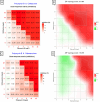Synergistic antimicrobial combination of third-generation cephalosporins and polymyxin B against carbapenem-polymyxin-resistant Klebsiella pneumoniae: an in vitro and in vivo analysis
- PMID: 39254296
- PMCID: PMC11459926
- DOI: 10.1128/aac.00930-24
Synergistic antimicrobial combination of third-generation cephalosporins and polymyxin B against carbapenem-polymyxin-resistant Klebsiella pneumoniae: an in vitro and in vivo analysis
Abstract
Antibiotic combination therapy is a promising approach to address the urgent need for novel treatment options for infections caused by carbapenem-polymyxin-resistant Klebsiella pneumoniae (CPR-Kp). The present study aimed to investigate the synergistic potential of four cephalosporins in combination with polymyxin B (PMB). A checkerboard assay was performed to evaluate the synergistic effects of cephalexin (CLX), cefixime, cefotaxime (CTX), and cefmenoxime (CMX) in combination with PMB. Subsequently, experiments evaluating the use of CTX or CMX in combination with PMB (CTX-PMB or CMX-PMB, respectively), including growth curve and SynergyFinder analysis, antibiofilm activity assays, cell membrane integrity assays, and scanning electron microscopy, were performed. Safety assessments were also conducted, including hemolysis and toxicity evaluations, using Caenorhabditis elegans. Furthermore, an in vivo model in C. elegans was adopted to assess the treatment efficacy against CPR-Kp infections. CTX-PMB and CMX-PMB exhibited low fractional inhibitory concentration indexes ranging from 0.19 to 0.50 and from 0.25 to 1.5, respectively, and zero interaction potency scores of 37.484 and 15.076, respectively. The two combinations significantly reduced growth and biofilm formation in CPR-Kp. Neither CTX-PMB nor CMX-PMB compromised bacterial cell integrity. Safety assessments revealed a low hemolysis percentage and high survival rates in the C. elegans toxicity evaluations. The in vivo model revealed that the CTX-PMB and CMX-PMB treatments improved the survival rates of C. elegans. The synergistic effects of the CTX-PMB and CMX-PMB combinations, both in vitro and in vivo, indicate that these antibiotic pairings could represent effective therapeutic options for infections caused by CPR-Kp.
Keywords: Caenorhabditis elegans; Klebsiella pneumoniae; antimicrobial resistance; cephalosporins; combination therapy.
Conflict of interest statement
The authors declare no conflict of interest.
Figures







References
-
- Stewart AG, Bauer MJ, Butkiewicz D, Hinton A, Henderson A, Harris PNA, Paterson DL. 2023. In-vitro activity of oral third-generation cephalosporins plus clavulanate against ESBL-producing Enterobacterales isolates from the MERINO trial. Int J Antimicrob Agents 62:106858. doi:10.1016/j.ijantimicag.2023.106858 - DOI - PubMed
-
- da Silva KE, Baker S, Croda J, Nguyen TNT, Boinett CJ, Barbosa LS, Tetila A, Simionatto S. 2020. Risk factors for polymyxin-resistant carbapenemase-producing Enterobacteriaceae in critically ill patients: an epidemiological and clinical study. Int J Antimicrob Agents 55:105882. doi:10.1016/j.ijantimicag.2020.105882 - DOI - PubMed
Publication types
MeSH terms
Substances
Grants and funding
- 88887.833491/2023-00/Coordenação de Aperfeiçoamento de Pessoal de Nível Superior (CAPES)
- 76/2023 and 113/2023/Fundação de Apoio ao Desenvolvimento do Ensino, Ciência e Tecnologia do Estado de Mato Grosso do Sul (FUNDECT)
- 405829/2021-3, 408778/2022-9, 307946/2022-3, 444735/2023-2/Conselho Nacional de Desenvolvimento Científico e Tecnológico (CNPq)
LinkOut - more resources
Full Text Sources
Medical

